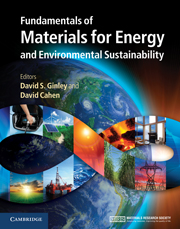Book contents
- Frontmatter
- Contents
- Contributors
- Preface
- Acknowledgments
- Part 1 Energy and the environment: the global landscape
- Part 2 Nonrenewable energy sources
- Part 3 Renewable energy sources
- 17 Solar energy overview
- 18 Direct solar energy conversion with photovoltaic devices
- 19 Future concepts for photovoltaic energy conversion
- 20 Concentrating and multijunction photovoltaics
- 21 Concentrating solar thermal power
- 22 Solar thermoelectrics: direct solar thermal energy conversion
- 23 Off-grid solar in the developing world
- 24 Principles of photosynthesis
- 25 Biofuels and biomaterials from microbes
- 26 Biofuels from cellulosic biomass via aqueous processing
- 27 Artificial photosynthesis for solar energy conversion
- 28 Engineering natural photosynthesis
- 29 Geothermal and ocean energy
- 30 Wind energy
- Part 4 Transportation
- Part 5 Energy efficiency
- Part 6 Energy storage, high-penetration renewables, and grid stabilization
- Summary
- Appendix A Thermodynamics
- Appendix B Electrochemistry
- Appendix C Units
- Index
- References
20 - Concentrating and multijunction photovoltaics
from Part 3 - Renewable energy sources
Published online by Cambridge University Press: 05 June 2012
- Frontmatter
- Contents
- Contributors
- Preface
- Acknowledgments
- Part 1 Energy and the environment: the global landscape
- Part 2 Nonrenewable energy sources
- Part 3 Renewable energy sources
- 17 Solar energy overview
- 18 Direct solar energy conversion with photovoltaic devices
- 19 Future concepts for photovoltaic energy conversion
- 20 Concentrating and multijunction photovoltaics
- 21 Concentrating solar thermal power
- 22 Solar thermoelectrics: direct solar thermal energy conversion
- 23 Off-grid solar in the developing world
- 24 Principles of photosynthesis
- 25 Biofuels and biomaterials from microbes
- 26 Biofuels from cellulosic biomass via aqueous processing
- 27 Artificial photosynthesis for solar energy conversion
- 28 Engineering natural photosynthesis
- 29 Geothermal and ocean energy
- 30 Wind energy
- Part 4 Transportation
- Part 5 Energy efficiency
- Part 6 Energy storage, high-penetration renewables, and grid stabilization
- Summary
- Appendix A Thermodynamics
- Appendix B Electrochemistry
- Appendix C Units
- Index
- References
Summary
Focus
Sunlight has two fundamental characteristics that make its use as a cost-effective large-scale source of electricity challenging: its low power density and its broad spectrum. The first characteristic means that sunlight has to be collected over large areas to gather significant amounts of power, and the second characteristic means that conventional solar cells are inherently limited in converting this power to electricity. The “concentrator photovoltaics” (CPV) approach using multijunction solar cells addresses these two challenges head-on.
Synopsis
Sunlight shines with a power of about 1 kW m−2, on average, onto the Earth's surface. Although this might feel considerable to a beachgoer on a hot sunny day, for electrical power generation, this power density is actually inconveniently small. For perspective, consider that a typical electrical power plant generates 1 GW, enough to supply the needs of a rather small city and about 0.1% of the total electricity generation capacity in the USA. The very best conventional solar cells are of efficiency about 20%, so to make a 1-GW solar photovoltaic power plant would require at least 5 km2 of solar cells. To gather sunlight over such large areas and convert it to electricity economically is a fundamental challenge of photovoltaics. One approach, discussed in other chapters, is to reduce the cost of the solar cells. In contrast, this chapter describes an alternative approach that reduces the amount of cells needed: CPV.
- Type
- Chapter
- Information
- Publisher: Cambridge University PressPrint publication year: 2011



